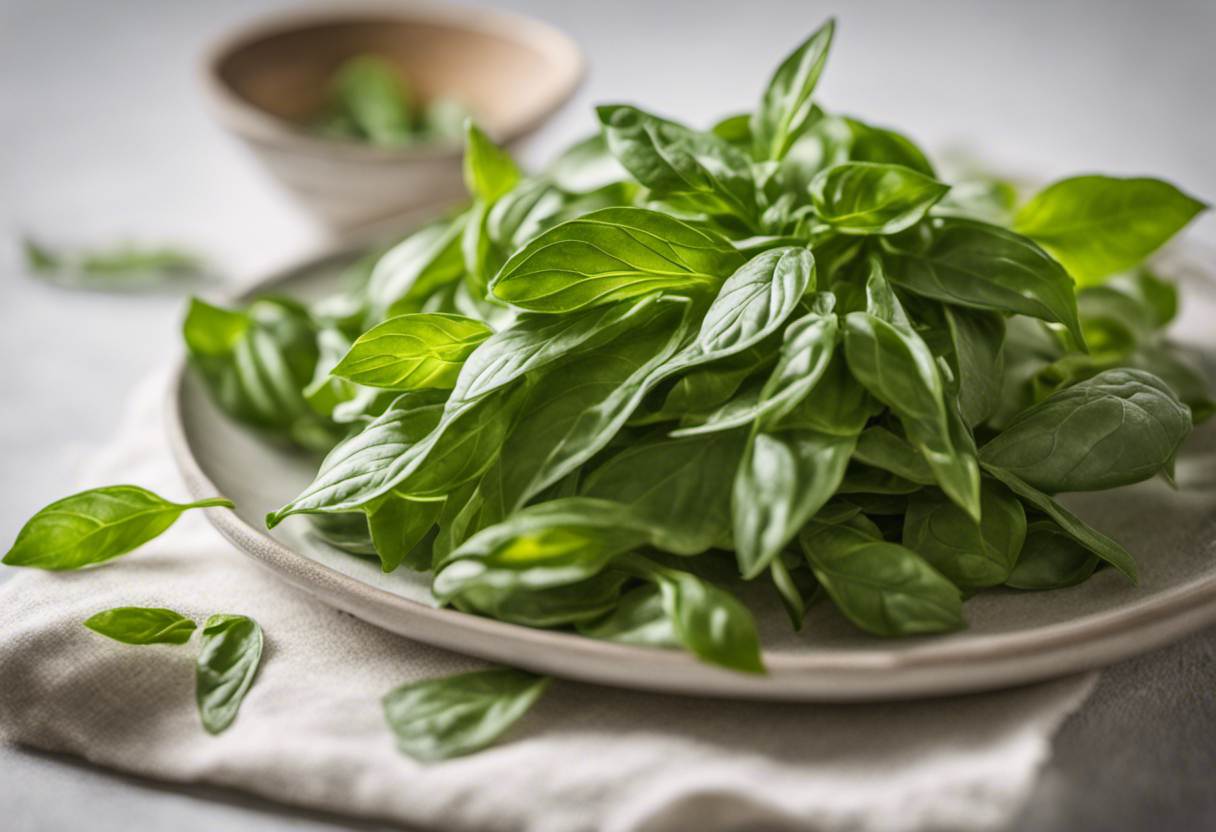Thai Basil in Italian Cooking: A Fusion of Flavors
Ever thought about spicing up your spaghetti with a dash of Thai basil? You might be surprised to learn that this aromatic herb, typically associated with Southeast Asian cuisine, can add an exciting twist to your favorite Italian dishes. Let’s dive into the world of Thai basil and explore how it can revolutionize your Italian cooking experience.
What’s the Deal with Thai Basil?
Before we jump into the culinary adventures, let’s get to know our star ingredient a bit better. Thai basil, also known as holy basil or “horapha” in Thai, is a variety of basil native to Southeast Asia. It’s got a distinct flavor profile that sets it apart from its Italian cousin – think anise and licorice with a hint of spiciness.
The leaves of Thai basil are narrower and more pointed than sweet basil, with a purple stem and flowers. It’s got a robust aroma that can stand up to high heat, making it perfect for stir-fries and, as we’ll soon discover, Italian cuisine.
Thai Basil Meets Italian Cuisine: A Match Made in Culinary Heaven
Now, you might be wondering, “Thai basil in Italian cooking? Really?” Yep, you heard that right! This unexpected combination can lead to some seriously delicious results. The unique flavor of Thai basil can add depth and complexity to traditional Italian dishes, creating a fusion that’ll make your taste buds dance.
Pasta Perfection with a Thai Twist
Let’s start with everyone’s favorite – pasta. Try tossing some chopped Thai basil into your tomato-based pasta sauces. The herb’s slightly spicy, anise-like flavor complements the acidity of tomatoes beautifully. It’s especially great in a spicy arrabbiata sauce, where it can enhance the heat while adding its own unique character.
For a quick and easy Thai basil pasta, try this: sauté garlic and chili flakes in olive oil, add cooked pasta, a handful of chopped Thai basil, and a squeeze of lemon. Finish with a sprinkle of Parmesan, and voila! You’ve got a simple yet flavorful dish that bridges Italian and Thai cuisines.
Pizza Party: Thai Basil Style
Who doesn’t love a good pizza? Next time you’re making one at home, try swapping out the traditional sweet basil for Thai basil. It pairs wonderfully with classic toppings like mozzarella and tomatoes, adding an unexpected but delightful flavor twist.
For a more adventurous pizza, try a Thai-inspired topping combo: Thai basil, grilled chicken, red onions, and a drizzle of sweet chili sauce. It’s a fusion pizza that’ll knock your socks off!
Pesto with a Punch
Pesto lovers, this one’s for you. While nothing beats a classic Genovese pesto, a Thai basil version can be a game-changer. Blend Thai basil with garlic, pine nuts (or cashews for a nuttier flavor), Parmesan cheese, and olive oil. The result? A vibrant, aromatic pesto that’s fantastic on pasta, as a spread on sandwiches, or as a dip for breadsticks.
Risotto Reimagined
Risotto is another Italian classic that can benefit from a touch of Thai basil. Try stirring in some chopped Thai basil just before serving your next mushroom or seafood risotto. The herb’s unique flavor profile can add an intriguing dimension to the creamy, comforting dish.
Growing Your Own Thai Basil for Italian Cooking
If you’re sold on the idea of using Thai basil in your Italian cooking adventures, why not grow your own? Thai basil is relatively easy to grow, either in a garden or in pots on a sunny windowsill. Having fresh Thai basil on hand means you can experiment with it in your Italian dishes whenever the mood strikes.
To grow Thai basil, plant the seeds in well-draining soil and place them in a spot that gets plenty of sunlight. Water regularly, but be careful not to overwater. Once the plants are established, pinch off the tops to encourage bushier growth and prevent flowering, which can make the leaves bitter.
The Cultural Significance of Fusion Cooking

Using Thai basil in Italian cooking is more than just a culinary experiment – it’s a celebration of the global nature of modern cuisine. As our world becomes more connected, our food naturally follows suit. This fusion of Thai and Italian flavors represents the beautiful melding of cultures through food.
By incorporating Thai basil into Italian dishes, we’re not just creating new flavor combinations; we’re also paying homage to the rich culinary traditions of both cultures. It’s a delicious way to broaden our culinary horizons and appreciate the diversity of global cuisines.
Wrapping Up: Thai Basil – Your New Italian Cooking Secret Weapon
So there you have it – a deep dive into the world of Thai basil in Italian cooking. From pasta and pizza to pesto and risotto, this versatile herb can add a unique twist to your favorite Italian dishes. Whether you’re an adventurous home cook or a professional chef looking to shake things up, Thai basil offers endless possibilities for culinary creativity.
Next time you’re in the kitchen whipping up an Italian feast, why not reach for some Thai basil? You might just discover your new favorite flavor combination. Happy cooking, and buon appetito… with a Thai twist!




